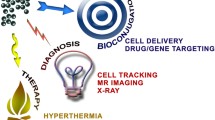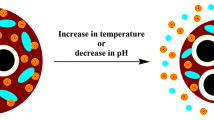Abstract
One of the most important and novel approaches of biomedical engineering is the development of new, effective and non-invasive medical diagnosis abilities, and treatments that have such requirements as advanced technologies for tumor imaging. Gadolinium (Gd) compounds can be used as MRI contrast agents, however the release of Gd3+ ions presents some adverse side effects such as renal failure, pancreatitis or local necrosis. The main aim of the work was the development and optimization of Gadolinium based nanoparticles coated with silica to be used as bioimaging agent. Gd based nanoparticles were prepared through a precipitation method and afterwards, these nanoparticles were covered with silica, using Stöber method with ammonia and functionalized with 3-Aminopropyltriethoxysilane (APTES). Results showed that nanoparticles were homogeneous regarding chemical composition, silica layer thickness, total size and morphology. Also, silica coating was successfully not degraded after 4 weeks at pH 5.5, 6.0 and 7.4, contrary to GdOHCO3 nanoparticles that degraded. Regarding the in vitro cell tests, very good cell proliferation and viability were observed. In conclusion, the results showed that Gd based nanoparticles coated with silica for imaging applications were successfully obtained under a well-controlled method. Furthermore, silica coating may enhance magnetic nanoparticles biosafety because it avoids GdOHCO3 degradation into harmful products (such as Gd3+ ions) at physiological conditions.
Graphical Abstract








Similar content being viewed by others
References
Kim KS, Park W, Hu J, Bae YH, Na K. A cancer-recognizable MRI contrast agents using pH-responsive polymeric micelle. Biomaterials. 2014;35:337–43.
Fukumori Y, Ichikawa H. Nanoparticles for cancer therapy and diagnosis. Adv Powder Technol. 2006;17:1–28.
Pankhurst QA, Connolly J, Jones S, Dobson J. Applications of magnetic nanoparticles in biomedicine. J Phys D. 2003;36:R167
Fricker SP. The therapeutic application of lanthanides. Chem Soc Rev. 2006;35:524–33.
Wang Y-XJ. Superparamagnetic iron oxide based MRI contrast agents: current status of clinical application. Quant Imaging Med Surg. 2011;1:35–40.
Yan G-P, Robinson L, Hogg P. Magnetic resonance imaging contrast agents: overview and perspectives. Radiography. 2007;13:e5–e19.
Paus T, et al. Maturation of white matter in the human brain: a review of magnetic resonance studies. Brain Res Bull. 2001;54:255–66.
Hahn MA, Singh AK, Sharma P, Brown SC, Moudgil BM. Nanoparticles as contrast agents for in vivo bioimaging: current status and future perspectives. Anal Bioanal Chem. 2011;399:3–27.
Kim SM, et al. Mn 2+-doped silica nanoparticles for hepatocyte-targeted detection of liver cancer in T 1-weighted MRI. Biomaterials. 2013;34:8941–48.
Decan N, et al. Characterization of in vitro genotoxic, cytotoxic and transcriptomic responses following exposures to amorphous silica of different sizes. Mutat Res Genetic Toxicol Environ Mutagen. 2016;796:8–22.
Kobayashi Y, Morimoto H, Nakagawa T, Gonda K, Ohuchi N. Preparation of silica-coated gadolinium compound particle colloid solution and its application in imaging. Adv Nano Res. 2013;1:159–69.
Mekaru H, Lu J, Tamanoi F. Development of mesoporous silica-based nanoparticles with controlled release capability for cancer therapy. Adv Drug Deliv Rev. 2015;95:40–9.
Kobayashi Y, et al. Fabrication of hollow particles composed of silica containing gadolinium compound and magnetic resonance imaging using them. J Nanostructure Chem. 2013;3:1–6.
Kobayashi Y, et al. Control of shell thickness in silica-coating of Au nanoparticles and their X-ray imaging properties. J Colloid Interface Sci. 2011;358:329–33.
Cao M, et al. Gadolinium (III)-chelated silica nanospheres integrating chemotherapy and photothermal therapy for cancer treatment and magnetic resonance imaging. ACS Appl Mater Interfaces. 2015;7:25014–23.
Atabaev TS, et al. Multicolor nanoprobes based on silica-coated gadolinium oxide nanoparticles with highly reduced toxicity. RSC Adv. 2016;6:19758–62.
Kumar S, Meena VK, Hazari PP, Sharma RK. FITC-Dextran entrapped and silica coated gadolinium oxide nanoparticles for synchronous optical and magnetic resonance imaging applications. Int J Pharm. 2016;506:242–52.
Chen S, et al. Sol–gel synthesis and microstructure analysis of amino-modified hybrid silica nanoparticles from aminopropyltriethoxysilane and tetraethoxysilane. J Am Ceram Soc. 2009;92:2074–82.
Di W, Ren X, Zhang L, Liu C, Lu S. A facile template-free route to fabricate highly luminescent mesoporous gadolinium oxides. CrystEngComm. 2011;13:4831–3.
Matijević E, Hsu WP. Preparation and properties of monodispersed colloidal particles of lanthanide compounds: I. Gadolinium, europium, terbium, samarium, and cerium (III). J Colloid Interface Sci. 1987;118:506–23.
Rao AV, Bhagat SD. Synthesis and physical properties of TEOS-based silica aerogels prepared by two step (acid–base) sol–gel process. Solid State Sci. 2004;6:945–52.
Canton G, Ricco R, Marinello F, Carmignato S, Enrichi F. Modified Stöber synthesis of highly luminescent dye-doped silica nanoparticles. J Nanopart Res. 2011;13:4349–56.
Brinker CJ, Scherer GW, editors. Sol–gel science. Boston: Academic Press; 1990. pp. 96–233.
Marshall G, Kasap C. Adve1rse events caused by MRI contrast agents: implications for radiographers who inject. Radiography. 2012;18:132–6.
Acknowledgements
The authors would like to acknowledge Dr. Yoshimitsu Kuwahara from Graduate School of Life Science and Systems Engineering at Kyushu Institute of Technology and Dr. Eiji Fujii from Industrial Technology Center of Okayama Prefecture for their support in TEM analysis. They also would like to acknowledge Prof. Masaki Mito from Faculty of Engineering at Kyushu Institute of Technology and Center for Instrumental Analysis, Kyushu Institute of Technology, for his support in SQUID analysis; Prof. Satoshi Hayakawa and Dr. Tomohiko Yoshioka from Graduate School of Natural and Science Technology at Okayama University for their support in SAA analysis and Dr. Anabela Dias and department of Física Médica from IPO—Instituto Português de Oncologia Dr. Francisco Gentil-centro Regional do Norte, for the help with MR images. This work was financed by FEDER—Fundo Europeu de Desenvolvimento Regional funds through the COMPETE 2020—Operacional Programme for Competitiveness and Internationalisation (POCI), Portugal 2020, and by Portuguese funds through FCT—Fundação para a Ciência e a Tecnologia/Ministério da Ciência, Tecnologia e Inovação in the framework of the project “Institute for Research and Innovation in Health Sciences” (POCI-01-0145-FEDER-007274). Authors would also like to thank to SFRH/BPD/87713/2012 individual post-doctoral fellowship supported by FCT. The work was also co-financed by the Ministry of Education, Culture, Sports, Science and Technology (MEXT) of Japan through the program “Promotion and Standardization of the Tenure-Track System (Ko**senbatsu)”.
Author information
Authors and Affiliations
Corresponding author
Ethics declarations
Conflict of interest
The authors declare that they have no conflict of interest.
Rights and permissions
About this article
Cite this article
Laranjeira, M., Shirosaki, Y., Yoshimatsu Yasutomi, S. et al. Enhanced biosafety of silica coated gadolinium based nanoparticles. J Mater Sci: Mater Med 28, 46 (2017). https://doi.org/10.1007/s10856-017-5855-1
Received:
Accepted:
Published:
DOI: https://doi.org/10.1007/s10856-017-5855-1




